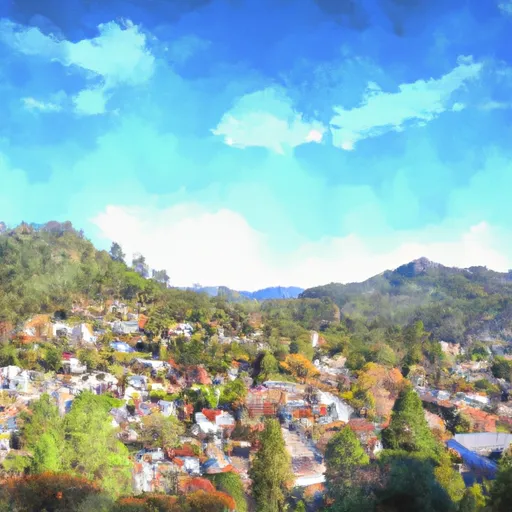-
 Snoflo Premium
Snoflo Premium
Get unlimited access to all our content
With no Ad interruptions! - Start Your Free Trial Login with existing account
Whiskeytown
Eden Index
Climate
8.6
•
Recreation
7.3
•
Community
•
Safeguard
6.0/10

Whiskeytown, California is a picturesque destination nestled in the Trinity Mountains, known for its stunning natural beauty and outdoor recreation opportunities. The climate in Whiskeytown is characterized by hot, dry summers and cool, wet winters. It experiences a Mediterranean climate, with average temperatures ranging from 45°F (7°C) in the winter to 95°F (35°C) in the summer.
Hydrologically, Whiskeytown is renowned for its crystal-clear lake, which is fed by the Trinity River and several smaller creeks. The lake offers various water activities such as swimming, boating, fishing, and kayaking. It is also surrounded by lush forests and scenic hiking trails, making it an ideal destination for nature enthusiasts.
For outdoor recreation, Whiskeytown offers several opportunities. Visitors can explore the expansive Whiskeytown National Recreation Area, which encompasses over 39,000 acres of land. The park features numerous trails for hiking and mountain biking, including the popular Brandy Creek Falls Trail and the Shasta Divide Trail. Additionally, there are camping grounds, picnic areas, and opportunities for wildlife viewing and birdwatching.
In conclusion, Whiskeytown, California is a nature lover's paradise, offering a Mediterranean climate, a pristine lake, and a wealth of outdoor recreation opportunities that cater to all interests and abilities.
What is the Eden Index?
The Snoflo Eden Index serves as a comprehensive rating system for regions, evaluating their desirability through a holistic assessment of climate health, outdoor recreation opportunities, and natural disaster risk, acknowledging the profound impact of these factors on livability and well-being.
Climate Health Indicator (CHI): 8.6
Whiskeytown receives approximately
1710mm of rain per year,
with humidity levels near 61%
and air temperatures averaging around
16°C.
Whiskeytown has a plant hardyness factor of
8, meaning
plants and agriculture in this region tend to thrive here all year round.
By considering the ideal temperature range, reliable water supplies, clean air, and stable seasonal rain or snowpacks, the Climate Health Indicator (CHI) underscores the significance of a healthy climate as the foundation for quality living.
A healthy climate is paramount for ensuring a high quality of life and livability in a region, fostering both physical well-being and environmental harmony. This can be characterized by ideal temperatures, reliable access to water supplies, clean air, and consistent seasonal rain or snowpacks.
Weather Forecast
Streamflow Conditions
Lower Sacramento
Area Rivers
Lower Sacramento
Snowpack Depths
Lower Sacramento
Reservoir Storage Capacity
Lower Sacramento
Groundwater Levels
Recreational Opportunity Index (ROI): 7.3
The Recreational Opportunity Index (ROI) recognizes the value of outdoor recreational options, such as parks, hiking trails, camping sites, and fishing spots, while acknowledging that climate plays a pivotal role in ensuring the comfort and consistency of these experiences.
Access to outdoor recreational opportunities, encompassing activities such as parks, hiking, camping, and fishing, is crucial for overall well-being, and the climate plays a pivotal role in enabling and enhancing these experiences, ensuring that individuals can engage in nature-based activities comfortably and consistently.
Camping Areas
| Campground | Campsites | Reservations | Toilets | Showers | Elevation |
|---|---|---|---|---|---|
| Lakeshore East | 32 | 1,028 ft | |||
| Preacher Meadow | 45 | 2,966 ft | |||
| Nelson Point | 9 | 1,091 ft | |||
| Lower Salt Creek - Dispersed | None | 1,045 ft | |||
| Jackass Spring | 21 | 2,562 ft | |||
| Antlers | 57 | 1,106 ft | |||
| Brandy Creek RV | 2 | 1,224 ft | |||
| Gregory Creek | 18 | 1,092 ft | |||
| Shasta (OHV) | 23 | 627 ft | |||
| Beehive Point - dispersed | None | 1,083 ft |
Nearby Fishing
Nearby Ski Areas
Catastrophe Safeguard Index (CSI):
The Catastrophe Safeguard Index (CSI) recognizes that natural disaster risk, encompassing floods, fires, hurricanes, and tornadoes, can drastically affect safety and the overall appeal of an area.
The level of natural disaster risk in a region significantly affects safety and the overall livability, with climate change amplifying these risks by potentially increasing the frequency and intensity of events like floods, fires, hurricanes, and tornadoes, thereby posing substantial challenges to community resilience and well-being.
Community Resilience Indicator (CRI):
The Community Resilience Indicator (CRI) recognizes that education, healthcare, and socioeconomics are crucial to the well-being of a region. The CRI acknowledges the profound impact of these elements on residents' overall quality of life. By evaluating educational resources, healthcare accessibility, and economic inclusivity, the index captures the essential aspects that contribute to a thriving community, fostering resident satisfaction, equity, and social cohesion.

